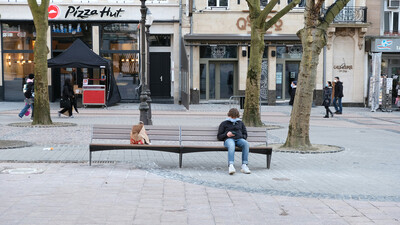Plazas and public squares are central to the design of urban areas, maintaining continuity throughout the built environment and providing places for people to meet and interact socially in an informal environment. They can be used for temporary events such as markets and fairs, venues for buskers and street performers, and focal points for protests and remembrances.
However, as they are largely paved with non-porous materials such as stone and concrete, they require efficient drainage systems to prevent the consequences of flooding and encourage water attenuation.
Why Poor Drainage is Bad for Plazas and Public Squares
A large, non-porous expanse of stone or concrete paving will quickly develop problems if it isn’t properly drained. Standing water will limit the area’s functionality and encourage the growth of moss and algae, which are not only unsightly but also a slip hazard when wet. Rainwater that cannot escape via a drainage system can erode the sub-surface underneath paving, leading to unstable and uneven surfaces that become trip hazards and suffer damage more easily.
In short, a poorly drained public square or plaza is a high-maintenance financial liability and an eyesore, two factors that local authorities and commercial landlords seek to avoid.
How Can Plaza Drainage be Improved?
Permeable surfaces
Concerns about the environmental effects of non-porous surfaces in urban areas have led to the development of more permeable alternatives such as porous concrete and permeable asphalt. However, while these materials improve rainfall attenuation by allowing water to filter through to the subsoil, they also present challenges.
Durability
Permeable surfaces are less durable, particularly if heavy vehicles are driven across them. As it retains moisture, porous concrete is more prone to deterioration caused by the freeze-thaw cycle of the winter months. Permeable asphalt is less resistant to deterioration than conventional asphalt if exposed to high temperatures or heavy rainfall.
Maintenance
Porous and permeable surfaces act like giant filters, trapping fine particles of dust and dirt while letting water pass through. Over time, these particles clog up the surface and reduce its drainage capabilities. This can be restored to an extent by pressure washing the surface, but this is a process that also contributes to the surface’s deterioration.
Water retention also encourages the growth of moss and lichen, and these are both unsightly and a slip hazard when wet.
Gutters and Gullies
Cast concrete gutters can be used as surface channels to direct rainwater to gullies and from there via underground pipes to a storm drain or soakaway. However, the disadvantage of this method is that when gully traps become blocked with debris, the rainwater accumulates in the gutters and temporarily floods the area. A gutter and gully system must, therefore, be regularly maintained to ensure efficient drainage.
Another problem is that although gutters are quite shallow, they can still be a trip hazard to the unwary or elderly. The slots in a gully grating may also need to be reasonably wide to allow rapid drainage, which can become another trip hazard. Compensation for injuries can potentially make this an expensive option in the long term.
Channel Drains
A channel drain can also be described as an enclosed gutter and gully system. A series of cast channels – often cast in polymer concrete for durability – function both as a drain and a short-term reservoir for rainwater, while gratings cover the entire length of the channel. Made of stainless steel or cast iron, these gratings allow a level surface for walking across and prevent larger pieces of debris from falling into the channel. They can also be easily removed to allow the channel to be regularly cleaned out.
As with a gutter and gully system, rainwater flows from the channel drain via pipes to a stormwater drain or soakaway, but as the channel is deeper than a gutter and is covered by a grating, it can hold a greater volume of water without flooding and can still be walked across during and after heavy rainfall. This reservoir function also means that when its outlets are working at full capacity, a channel drain system can contain water over a wider area rather than create localised flooding at vulnerable points.
Channel Drains: The Aesthetic Choice
In addition to being a highly efficient drainage system, channel drains can make a positive contribution to the overall look of a public square or plaza.
Traditional drainage solutions, such as square or round gullies, can be large, visually intrusive distractions from the clean lines of urban landscaping. Channel drains, on the other hand, are designed as a subtle, streamlined feature that complements paved areas. The gratings used to cover channel drains in such environments can be made from stainless steel for a sleek, contemporary finish or in cast iron to perfectly complement a more traditional setting.
At Drainfast, we stock a wide and varied range of channel drainage products, ensuring we can provide you with a system that perfectly meets your aesthetic design objectives, your project’s drainage capacity and a load rating that will ensure long-lasting durability. Call 01420 555600 or leave a message on our online contact page for professional advice, high-quality products and excellent customer service.

Written by
Bob Stone
Technical Sales
Heading up our Technical Estimating Department, Bob is our in-house quantity surveyor.

